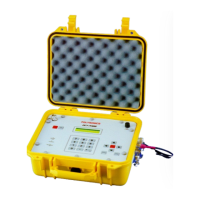Appendix C
A-107
25. Exit from the upgrade procedure by holding down the
ALT
key while pressing
X
.
NOTE 1: If a prompt is displayed on the DDF4088 requesting a serial number, refer to
Section A.6.3.
NOTE 2: If using a DDF3088, complete the following steps:
!
Exit the upgrade procedure by restarting the DDF3088. (To restart the
unit, hold down the two shift buttons and the red power button for several
seconds until the screen turns black.)
!
After all flowmeters have been upgraded, use HCOM to delete the
unzipped software upgrade files from the DDF3088. (This allows more
space for recording data log files.)
A.6.3 ENTERING THE SERIAL NUMBER FOR DDF4088 UPGRADES
If a DDF4088 was upgraded from version 1.1 to any higher version, the following is
displayed after the flowmeter initializes with the new software:
ENTER SERIAL #
=
Enter the serial number which is located on a label attached to the flowmeter (ignoring any
letters if present) and press
ENTER
.
IMPORTANT:
The serial number must be entered very carefully. The correct serial
number is essential if the flowmeter is being upgraded to multi-channel
operation. (It defaults to single-channel mode if entered incorrectly.)
Special service is required by the factory to remedy an incorrectly entered
serial number.
A.7 Graphical Signal Analysis for the DDF4088 and DDF4488
PolyLink can display a graphic representation of the signal received by a DDF4088 and
DDF4488. The signal analysis function allows the user to visually observe the signal being
received and interpret signal quality, the presence of interference, etc. This feature is
available whether PolyLink is run from an IBM-compatible PC or from a DDF3088.
Undesirable frequencies may be produced by a variety of sources at the measurement site
such as vibration, interference from motor controllers, etc. Special interference frequency
filters can be set and custom signal processing schemes designed for those difficult
applications where other instruments may not function at all.
The signal can be displayed as a waveform in the frequency (FFT) domain (Figure A-7) or
in the time (SIG) domain (Figure A-8).

